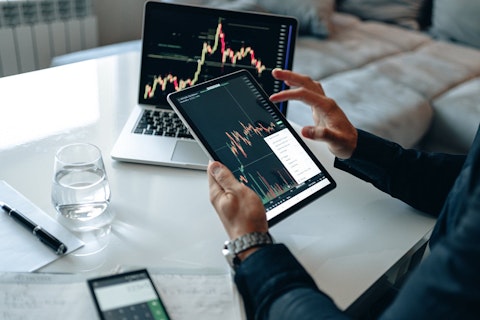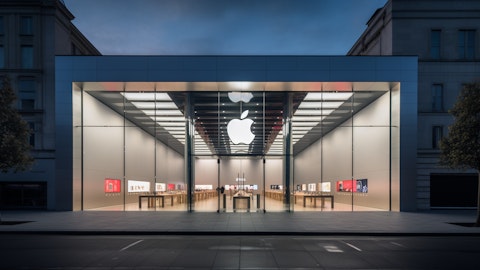In this article, we will be taking a look at the 10 most oversold stocks to buy according to billionaires.
Due to the uncertainty surrounding the tariff news, Wall Street is seeing some effects. Investors are mostly concerned about tariffs because they believe they could hinder economic development and lead to inflation, which is why the broader market has fallen significantly since Trump took office on January 20. While Trump claims tariffs can increase national revenue, encourage broad-based growth, and be used as a negotiating tool with other countries, investors worry that trade policies can lower consumer confidence and limit businesses’ capacity to spend capital.
Tariffs, Growth Fears, and Fed Policy
Wells Fargo Wealth and Investment Management CIO Darrell Cronk appeared on CNBC’s “Squawk on the Street” on April 28 to talk about market outlooks and what investors should consider given the current state of the market. He believed that rather than inflation, investors should be concerned about growth. According to Cronk, it is crucial to exercise caution when pursuing stocks too aggressively because the market is expected to present greater buying and entry opportunities in the upcoming weeks. Since the terms of the game can change incredibly quickly in our geopolitical-first environment, there is a widening gap between sentiment and positioning.
Cronk went on to say that many people only consider the inflationary aspect of tariffs, ignoring another important element. Tariffs cause inflation, but only when they impose price resets; they do not cause persistent inflation. Therefore, even while businesses must be prepared to withstand the impact of margins and the blunt force reset of prices, it’s not like the rate of change of inflation keeps getting noticeably larger from year one to years two, three, and four. Only when tariffs rise noticeably over time does this trend become apparent.
Cronk also discussed the president’s insistence that the Fed lower interest rates. Not only the president, but the bond market is following suit. The Fed must make decreases gradually. However, Cronk asserts that markets would not react well if the Fed appeared tomorrow and declared some kind of emergency cut. The growth worry would become more widespread and troublesome since the markets would interpret it as the Fed knowing something they don’t. For this reason, the Fed must exercise caution in its actions.
The Fed has consistently stated that it is more worried about inflation. The markets would view them as more dovish if they began to focus more on growth issues rather than inflation. He claimed that the president of the Fed recently stated that a rate cut in June would be conceivable. As a result, the Fed is beginning to set the foundation; we will have to wait and watch how that story develops. If it adopts a more dovish stance, markets would thoughtfully and strategically interpret that.
Nine out of the eleven S&P gig sectors have lowered their guidance since April 1. The issue is that less than 20% of the 20% to 25% of reported results that the market has currently seen have been willing to provide guidance. Cronk thus emphasized how crucial and harmful the guidance suspension is in this case. Therefore, the market needs tech to deliver and consumer discretionary stocks and industrials to hold up.

Source: pexels
Our Methodology
For our methodology, we first used a stock analysis screener to identify stocks with a market capitalization above $10 billion and a Relative Strength Index (RSI) below 40. From the filtered results, we selected the top 10 stocks and ranked them based on the number of billionaire investors holding positions, aligning with the focus of our analysis. In cases where multiple stocks had the same number of billionaire holders, we used the total dollar value of billionaire holdings as a tiebreaker, giving a higher rank to the stock with the greater investment value.
Why are we interested in the stocks that hedge funds pile into? The reason is simple: our research has shown that we can outperform the market by imitating the top stock picks of the best hedge funds. Our quarterly newsletter’s strategy selects 14 small-cap and large-cap stocks every quarter and has returned 373.4% since May 2014, beating its benchmark by 218 percentage points (see more details here).
Here is our list of the 10 most oversold stocks to buy according to billionaires.
10. Lineage, Inc. (NASDAQ:LINE)
Number of Billionaire Holdings: 6
Dollar Value of Billionaire Holdings: $246,614,432
Lineage, Inc. (NASDAQ:LINE) is the world’s largest temperature-controlled warehouse REIT, operating over 485 refrigerated facilities across 18 countries. The company provides cold storage and logistics solutions for major food producers, retailers, and distributors, helping keep perishable goods like food, beverages, and pharmaceuticals fresh and safe throughout the global supply chain.
Lineage, Inc. (NASDAQ:LINE), one of the most oversold stocks, reported revenue of $1.29 billion, which is down 3% year-over-year, reflecting a return to normal seasonal trends following years of elevated inventory. Adjusted EBITDA fell 7% to $304 million, with margins dipping to 23.5% due to reduced throughput revenue and some customer hesitancy tied to tariffs. However, AFFO per share rose 6% to $0.86, supported by strong cost controls and productivity gains driven by LinOS, the company’s proprietary warehouse execution system.
Lineage, Inc. (NASDAQ:LINE)’s appeal to billionaire investors lies in its strong automation edge, with LinOS reducing labor costs by 15% and boosting throughput at pilot sites. It’s strategic acquisitions, such as the $121 million purchase of three facilities from Bellingham Cold Storage, are enhancing its presence in key regions like the Pacific Northwest.
The corporation recently signed a multi-year deal with Tyson Foods to build and manage advanced cold storage facilities, further reinforcing its innovation leadership. The company is also expanding in Europe, upgrading high-utilization warehouses with semi- and fully automated systems to drive future growth and efficiency.
9. Watsco, Inc. (NYSE:WSO)
Number of Billionaire Holdings: 8
Dollar Value of Billionaire Holdings: $135,616,884
Watsco, Inc. (NYSE:WSO) is North America’s largest distributor of HVAC/R equipment, parts, and supplies, serving as a key link between manufacturers and contractors, or businesses that install and maintain these systems. Rather than manufacturing products, the company purchases HVAC units and related components from major brands and resells them to thousands of contractors and commercial clients. The company stands ninth among the most oversold stocks to buy according to billionaires.
Watsco, Inc. (NYSE:WSO) reported Q1 revenue of $1.53 billion, which is down 2.2% year-over-year, missing analyst estimates due to international weakness and ongoing product transition challenges. Despite a flat gross profit of $430 million, gross margin improved to 28.1% thanks to a stronger mix of high-efficiency products. Its earnings per share declined to $1.93 from $2.17, which reflected inventory-related costs tied to the company’s shift toward environmentally compliant A2L refrigerant systems.
Domestically, the company’s core U.S. residential replacement business remained strong, growing 10% and accounting for 91% of total sales. International sales, however, dropped 9% due to macroeconomic headwinds and currency pressure. The company is navigating a major product transition affecting over half of its sales, requiring close to $1 billion in inventory conversion. It is a move expected to drive long-term growth and compliance with new environmental regulations.
Billionaires are drawn to Watsco, Inc. (NYSE:WSO) for its stable, recession-resistant industry, long-standing dividend track record, now in its 51st year with an 11% hike to $12 per share, and strong balance sheet, boasting $432 million in cash and zero debt. The A2L refrigerant transition, though disruptive, positions the company for regulatory leadership and future margin expansion as competitors lag. The business’s recent developments include the continued rollout of digital tools to optimize pricing and inventory management, enhancing operational efficiency.
8. Westlake Corporation (NYSE:WLK)
Number of Billionaire Holdings: 8
Dollar Value of Billionaire Holdings: $191,011,247
Westlake Corporation (NYSE:WLK) stands eighth on our list of the most oversold stocks. It is a global industrial company that produces essential chemicals and finished goods used in everyday products like packaging, medical devices, construction materials, and automotive parts. It earns revenue by manufacturing and selling both raw materials and ready-to-use products to businesses across various industries worldwide.
In Q1 2025, Westlake Corporation (NYSE:WLK) reported $2.8 billion in revenue, maintaining stability despite global economic softness. Strength in the Housing and Infrastructure Products (HIP) segment, supported by steady construction activity and stable pricing, helped offset broader demand challenges.
The company’s EBITDA for the quarter totaled $288 million. The HIP segment stood out with a solid 20% EBITDA margin, while the Performance and Essential Materials (PEM) segment faced pressure from rising feedstock and energy costs, leading to overall margin compression.
The business posted a net loss of $40 million, or $0.31 per share, which was primarily due to high input costs, plant outages, and weak global demand. However, analysts view this as a cyclical low rather than a long-term trend, with expectations of recovery as industrial demand picks up.
Investors are drawn to Westlake Corporation (NYSE:WLK) ’s potential for upside during a recovery cycle, supported by the defensive nature of its HIP business, strong cash reserves of $2.5 billion, and a focus on cost control and reduced capital spending. The company continues to return value to shareholders through dividends and buybacks, demonstrating confidence in long-term growth.
The corporation’s recent developments include the completion of key plant upgrades and limited exposure to Chinese tariffs, positioning the company well for future growth. Additionally, a strategic inventory built in PVC ahead of the construction season could boost performance if demand rebounds.
7. Church & Dwight Co., Inc. (NYSE:CHD)
Number of Billionaire Holdings: 10
Dollar Value of Billionaire Holdings: $406,794,990
Church & Dwight Co., Inc. (NYSE:CHD) is a major U.S. consumer goods company known for producing household and personal care brands like Arm & Hammer, OxiClean, Spinbrush, Trojan, and Vitafusion. It generates revenue by manufacturing and selling these branded products through supermarkets, drugstores, wholesale clubs, and online platforms, reaching consumers globally through both physical and digital retail channels.
In Q1 2025, Church & Dwight Co., Inc. (NYSE:CHD) reported a 2.4% year-over-year revenue decline, with organic sales down 1.2% due to a 1.4% volume drop. The decline was largely driven by retailer destocking amid softer U.S. consumer demand. Despite this, the company gained market share in 9 of its 14 major brands, and over 80% of its portfolio saw volume share growth. Notably, online sales continued to rise, now making up nearly 23% of global sales.
The corporation’s profitability remained under pressure, with adjusted EPS down 5.2% to $0.91, though slightly above guidance. Gross margin fell to 45.1% as gains from productivity and product mix were outweighed by inflation and manufacturing costs. Its marketing spend declined to 9.3% of sales, with a full-year goal of 11% to support brand momentum.
Church & Dwight Co., Inc. (NYSE:CHD), considered one of the most oversold stocks, reported operating cash flow of $185.7 million, which is down due to lower cash earnings and working capital timing. The company maintained a healthy balance sheet, allocating $16.5 million in Q1 CapEx with plans to invest around $130 million for the year.
Strategically, the business is exiting low-margin businesses like Flawless, Spinbrush, and Waterpik showerheads—about 2% of total sales—to focus on stronger brands and reduce tariff exposure by roughly 80%. These moves align with its long-term focus on profitability and efficiency.
Investors are optimistic due to the company’s strong brand portfolio, defensive business model, and expanding digital presence. Recent innovations like BATISTE Light dry shampoo and new THERABREATH flavors, along with proactive cost controls and strategic pruning, are expected to drive renewed growth and margin recovery.
6. Healthpeak Properties, Inc. (NYSE:DOC)
Number of Billionaire Holdings: 11
Dollar Value of Billionaire Holdings: $133,205,622
Healthpeak Properties, Inc. (NYSE:DOC) is a healthcare real estate investment trust (REIT). It owns, operates, and develops real estate properties primarily for healthcare-tailored facilities.
In Q1 2025, the company reported solid financial results, with Funds From Operations (FFO) as adjusted at $0.46 per share and Adjusted FFO (AFFO) at $0.43. Same-store portfolio growth reached 7%, which was led by strong performances in Outpatient Medical (+5%), Lab (+7.7%), and especially Continuing Care Retirement Communities (CCRCs) at +15.9%. Leasing activity was a key growth driver, particularly in the outpatient segment, where nearly 1 million square feet were leased.
Healthpeak Properties, Inc. (NYSE:DOC)’s profitability remained stable, which was supported by effective cost control and the internalization of property management, which also helped expand the portfolio by 4.5 million square feet since January. The company maintained a strong balance sheet, with $2.8 billion in liquidity and a net debt-to-EBITDA ratio of 5.2x, healthy for a REIT. A $500 million unsecured note issuance at 5.375% further bolstered financial flexibility.
Investors are drawn to the corporation’s positioning in the defensive healthcare real estate sector, which is supported by demographic trends like an aging population and increasing healthcare demand. High-quality assets in medical and innovation hubs, combined with ongoing share buybacks and prudent capital management, signal confidence in long-term value.
Healthpeak Properties, Inc. (NYSE:DOC)’s recent developments include the internalization of property management, which is expected to improve margins, and a strategic partnership with Hines for the West Cambridge development. The company also benefits from cost-stable projects through fixed-price construction contracts, reducing inflation-related risks.
5. Hologic, Inc. (NASDAQ:HOLX)
Number of Billionaire Holdings: 11
Dollar Value of Billionaire Holdings: $302,755,147
Hologic, Inc. (NASDAQ:HOLX) is a global medical technology company focused on advancing women’s health through innovative products. It designs and sells medical imaging systems, diagnostic tests, and surgical tools used to detect and treat conditions like breast and cervical cancer.
Hologic, Inc. (NASDAQ:HOLX) reported Q2 2025 revenue of $1.01 billion, a 1.2% year-over-year decline, but still at the upper end of guidance. Non-GAAP EPS remained steady at $1.03, also hitting the high end of guidance. However, the company posted a GAAP net loss of $17.4 million due to non-cash impairment charges, a sharp drop from last year’s $169.9 million profit. Gross margin improved to 61.1%, reflecting better operational efficiency, while operating cash flow remained strong at $169.5 million, with cash reserves totaling $1.43 billion. Despite the earnings dip, HOLX may surface on lists tracking the most oversold stocks amid broader market volatility.
The company’s diagnostics segment continued to lead performance, with revenue up 1.5% (5.2% excluding COVID-related sales), which was driven by molecular diagnostics. Its breast health revenue declined 6.9% amid weaker mammography equipment sales and ongoing market softness. Surgical revenue rose 5.1%, boosted by the Gynesonics acquisition, while skeletal health showed strong growth, up 22.9%.
Hologic, Inc. (NASDAQ:HOLX) reaffirmed its full-year guidance of $4.05–$4.10 billion in revenue and non-GAAP EPS of $4.15–$4.25. Q3 revenue is expected to be between $1.00–$1.01 billion, with EPS of $1.04–$1.07. Despite stock pressure, the company remains attractive to investors due to its solid fundamentals, strong cash flow, continued share buybacks, and growth opportunities in molecular diagnostics and a potential rebound in breast health.
4. Zimmer Biomet Holdings, Inc. (NYSE:ZBH)
Number of Billionaire Holdings: 11
Dollar Value of Billionaire Holdings: $409,448,206
Zimmer Biomet Holdings, Inc. (NYSE:ZBH) designs, manufactures, and markets orthopedic reconstructive products. Additionally, it sells dental implants, trauma goods, sports medicine, biologics, extremities, and associated surgical supplies.
With a 36% market share in knee implants and a 23% market share in hip implants, the firm dominates the orthopedic industry. Because developing medical implants necessitates a drawn-out FDA approval procedure, which naturally limits competition and creates a barrier to entry, Zimmer Biomet Holdings, Inc. (NYSE:ZBH) also enjoys a competitive market advantage due to its regulatory experience.
Ryan Zimmerman, a BTIG analyst, set a price objective of $123.00 on April 25 and kept his buy rating on the stock unchanged. According to the analyst, the business is well-positioned to reclaim market share thanks to its recent strategic product introductions in the hip replacement industry.
Orthopedic surgeons have given the company’s cutting-edge products—such as the Z1 Triple Taper Stem, HAMMR, and OrthoGrid—generally positive reviews. By strengthening Zimmer Biomet Holdings, Inc. (NYSE:ZBH)’s competitive position, the items can bolster the Buy recommendation.
3. Becton, Dickinson and Company (NYSE:BDX)
Number of Billionaire Holdings: 13
Dollar Value of Billionaire Holdings: $983,675,084
The third stock on our list of the most oversold stocks is Becton, Dickinson and Company (NYSE:BDX), which is a medical technology company that develops, manufactures, and sells medical devices, instrument systems, and reagents. Its products are utilized to advance medical discovery research, increase drug delivery, and improve diagnostics.
The corporation’s strong Q2 2025 results as the industry leader in healthcare equipment and supplies are the reason for the positive outlook. Becton, Dickinson and Company (NYSE:BDX) reported earnings per share of $3.35 and a 4.5% increase in revenue to $5.3 billion. The corporation is worried about the effects of tariffs and says it anticipates $21.8 billion to $21.9 billion in revenue for the entire year, with diluted earnings per share (EPS) ranging from $14.06 to $14.34.
Furthermore, in reaction to the trade duties, Becton, Dickinson and Company (NYSE:BDX) plans to invest $2.5 billion in the US to increase its production capacity. Through new product launches and FDA approval, it also intends to enhance its product range and solidify its market leadership.
2. Tyson Foods, Inc. (NYSE:TSN)
Number of Billionaire Holdings: 14
Dollar Value of Billionaire Holdings: $349,702,882
Tyson Foods, Inc. (NYSE:TSN) is a global food company that processes and sells chicken, beef, and pork products. Its offerings range from raw meat cuts to ready-to-eat meals and popular branded items like Tyson Chicken Nuggets and Jimmy Dean sausages.
Tyson Foods, Inc. (NYSE:TSN) reported Q2 2025 sales of $13.1 billion, which include a $343 million legal contingency in its pork segment. Excluding this one-time charge, sales showed year-over-year growth. The chicken segment saw its second consecutive quarter of volume growth, while prepared foods maintained strong double-digit margins. Pork achieved its best Q2 adjusted operating income in three years, up 67% YoY. Although beef sales rose due to pricing, margins were impacted by elevated cattle costs.
The company’s profitability improved across the board, with adjusted operating income rising 27% year-over-year to $515 million and adjusted EPS jumping 48%. Operating margins also expanded by 70 basis points, reflecting ongoing efficiency efforts.
The business’s balance sheet remains healthy, with $846 million in year-to-date operating cash flow and $3.2 billion in liquidity after repaying a $750 million term loan. Free cash flow reached $382 million, supporting a $349 million dividend payout. The company reaffirmed its commitment to dividends and guided for FY25 sales to be flat or up 1%, with adjusted operating income expected between $1.9 billion–$2.3 billion.
Strategically, Tyson Foods, Inc. (NYSE:TSN) continues to focus on operational excellence through automation and plant optimization. Innovation remains a priority, with new product launches like Jimmy Dean chicken biscuits and the reformulation of products to eliminate synthetic dyes. These efforts align with sustainability goals and regulatory compliance.
Looking ahead, the company sees growth opportunities in international markets and premium, value-added protein products. Investors are encouraged by four consecutive quarters of growth in key financial metrics, margin expansion driven by supply chain improvements, and the company’s defensive positioning in consumer staples. Additionally, the firm’s warehouse modernization strategy is expected to generate $200 million in annual savings by 2030, reinforcing long-term efficiency gains.
1. UnitedHealth Group Incorporated (NYSE:UNH)
Number of Billionaire Holdings: 23
Dollar Value of Billionaire Holdings: $8,138,549,322
UnitedHealth Group Incorporated (NYSE:UNH) tops our list for being one of the most oversold stocks. It is a healthcare company that offers consumer-oriented health benefit plans and services. It also provides care delivery, wellness, and consumer engagement, and health financial services to patients.
Following the notable decline, research firm Baird has already reaffirmed its Buy recommendation for UnitedHealth Group Incorporated (NYSE:UNH), although it has lowered its price target from $640 to $510. The price reduction comes as investors reacted to rising Medicare expenditures, causing the corporation to experience its biggest one-day plunge of 22% in over a century. Because of the expansion of its Medicare Advantage business, the company managed to generate $6.3 billion in profit in the first quarter of 2025 despite the rising costs.
The stock also stands out because of its remarkable dividend growth and payment history over the previous 14 years. Its dividend yield of 1.4% is nearly identical to the average for the S&P 500. Furthermore, UnitedHealth Group Incorporated (NYSE:UNH) frequently uses acquisitions to expand its operations. In order to bolster its home health services even further, it has previously purchased the home health company Luck Group and is currently finalizing a $3.3 billion agreement for Amedisys.
Overall, UNH ranks first among the 10 most oversold stocks to buy according to billionaires. While we acknowledge the potential of oversold stocks our conviction lies in the belief that some AI stocks hold greater promise for delivering higher returns, and doing so within a shorter time frame. There is an AI stock that went up since the beginning of 2025, while popular AI stocks lost around 25%. If you are looking for an AI stock that is more promising than UNH but that trades at less than 5 times its earnings, check out our report about this cheapest AI stock.
READ NEXT: 20 Best AI Stocks To Buy Now and 30 Best Stocks to Buy Now According to Billionaires.
Disclosure: None. Insider Monkey focuses on uncovering the best investment ideas of hedge funds and insiders. Please subscribe to our free daily e-newsletter to get the latest investment ideas from hedge funds’ investor letters by entering your email address below.





